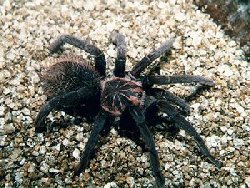From 1989 through 1992, status surveys were conducted for the spruce-fir moss spider and based on the results of these surveys, the spider is presently known to exist at only four locations--three sites in North Carolina and one in Tennessee. Of the four remaining populations, only one appears to be relatively stable. This population is located along the Avery/Caldwell County line in North Carolina. The other two populations in North Carolina are located in Swain County. Both of the Swain County populations are extremely small with only one spruce-fir moss spider having been found at each of these two sites in recent years. The forests at the two Swain County sites are rapidly declining. The Tennessee population is located in Sevier County. This population was considered healthy in 1989 but is currently believed to be declining in numbers and is endangered by habitat loss/alteration. The high-elevation spruce-fir forests throughout much of the species' historic range are being decimated by the balsam wooly adelgid (Adelges piceae)--an exotic insect pest--and possibly by air pollution (acid precipitation) and other factors not yet fully understood. The death and thinning of the forest canopy results in locally drastic changes in microclimate including increased temperatures and decreased moisture leading to desiccation of the moss mats on which the spruce-fir moss spider, and possibly its prey base, depend for survival.
